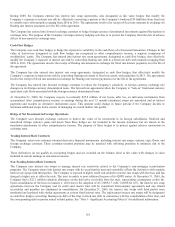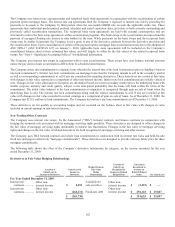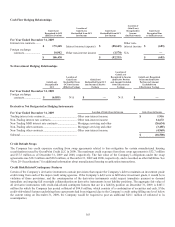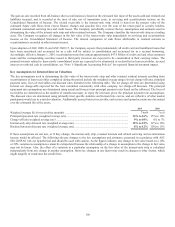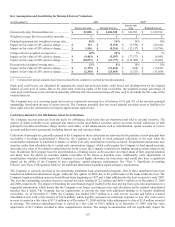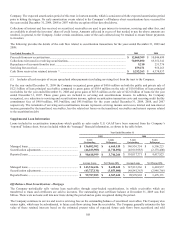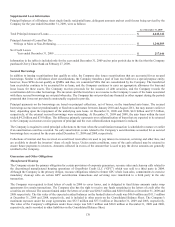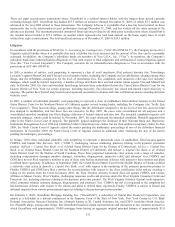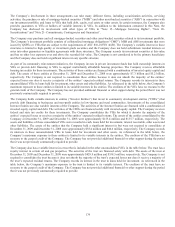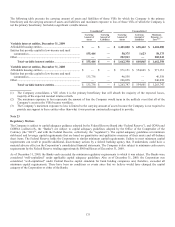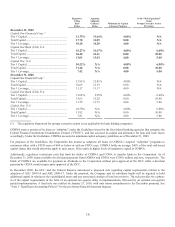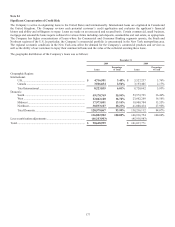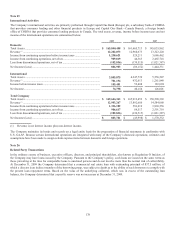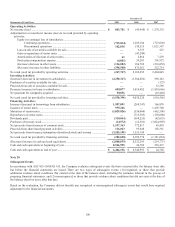Capital One 2009 Annual Report Download - page 184
Download and view the complete annual report
Please find page 184 of the 2009 Capital One annual report below. You can navigate through the pages in the report by either clicking on the pages listed below, or by using the keyword search tool below to find specific information within the annual report. 171
The principal balance of manufactured housing securitization transactions where the Company is the residual interest holder was $1.5
billion and $1.7 billion as of December 31, 2009 and 2008, respectively. In the event the third party does not fulfill on its obligations
to exercise the clean-up calls on certain transactions, the obligation reverts to the Company and approximately $420.3 million of loans
receivable would be assumed by the Company upon its execution of the clean-up call and the Company would be required to absorb
any losses on the loans receivable. There have been no instances of non-performance to date by the third party.
Management monitors the underlying assets for trends in delinquencies and related losses and reviews the purchaser’s financial
strength as well as servicing performance. These factors are considered in assessing the adequacy of the liabilities established for these
obligations and the valuations of the assets.
Securitization Guarantees
In connection with certain installment loan securitization transactions, the transferee (off-balance sheet special purpose entity
receiving the installment loans) entered into interest rate hedge agreements (the “swaps”) with a counterparty to reduce interest rate
risk associated with the transactions. In connection with the swaps, the Company entered into letter agreements guaranteeing the
performance of the transferee under the swaps. If at any time the Class A invested amount equals zero and the notional amount of the
swap is greater than zero resulting in an “Early Termination Date” (as defined in the securitization transaction’s Master Agreement),
then (a) to the extent that, in connection with the occurrence of such Early Termination Date, the transferee is obligated to make any
payments to the counterparty pursuant to the Master Agreement, the Company shall reimburse the transferee for the full amount of
such payment and (b) to the extent that, in connection with the occurrence of an Early Termination Date, the transferee is entitled to
receive any payment from the counterparty pursuant to the Master Agreement, the transferee will pay to the Company the amount of
such payment. At December 31, 2009 and 2008, the maximum exposure to the Company under the letter agreements was
approximately $3.5 million and $13.0 million respectively. These guarantees are not recorded on the balance sheet because they are
grandfathered under the provisions of FASB Interpretation 45, Guarantor’s Accounting and Disclosure Requirements for Guarantees,
Including Indirect Guarantees of Indebtedness of Others (“ASC 460-10/FIN 45”).
Neither the assets and liabilities recorded on the Consolidated Balance Sheet at December 31, 2009 related to the manufactured
housing securitizations nor the letter agreements associated with certain installment loan securitizations, both discussed above, are
impacted by the adoption of ASU 2009-17 (ASC 810/SFAS 167) at January 1, 2010. The applicable trusts will not be consolidated
and the related loans and debt securities will remain off-balance sheet.
Note 21
Commitments, Contingencies and Guarantees
Letters of Credit
The Company issues letters of credit (financial standby, performance standby and commercial) to meet the financing needs of its
customers. Standby letters of credit are conditional commitments issued by the Company to guarantee the performance of a customer
to a third party in a borrowing arrangement. Commercial letters of credit are short-term commitments issued primarily to facilitate
trade finance activities for customers and are generally collateralized by the goods being shipped to the client. Collateral requirements
are similar to those for funded transactions and are established based on management’s credit assessment of the customer.
Management conducts regular reviews of all outstanding letters of credit and customer acceptances, and the results of these reviews
are considered in assessing the adequacy of the Company’s allowance for loan and lease losses.
The Company had contractual amounts of standby letters of credit and commercial letters of credit of $1.6 billion at December 31,
2009. As of December 31, 2009, financial guarantees had expiration dates ranging from 2010 to 2020. The fair value of the guarantees
outstanding at December 31, 2009 that have been issued since January 1, 2003, was $3.1 million and was included in other liabilities.
Loan and Line of Credit Commitments
The Company’s discontinued wholesale mortgage banking unit, GreenPoint, previously sold home equity lines of credit in whole loan
sales and subsequently acquired a residual interest in certain SPEs which securitized some of those loans. Those SPEs had aggregate
assets of $56.8 million at December 31, 2009, representing the amount outstanding on the home equity lines of credit at that date. As
residual interest holder, GreenPoint is required to fund advances on the home equity lines of credit when certain performance triggers
are met due to deterioration in asset performance. GreenPoint’s ability to recover the full amount advanced to customers is dependent
on monthly collections on the loans. In certain limited circumstances, such future advances could be reduced if GreenPoint suspends
the right of mortgagors to receive draws or reduces the credit limit on home equity lines of credit.


